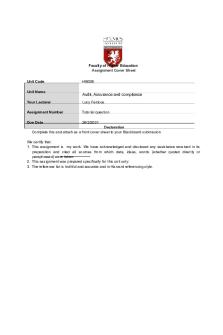Week09b RSA1 slides - cghj PDF

| Title | Week09b RSA1 slides - cghj |
|---|---|
| Author | kanish gupta |
| Course | Metrics, Quality And Reliability |
| Institution | La Trobe University |
| Pages | 12 |
| File Size | 569.2 KB |
| File Type | |
| Total Downloads | 3 |
| Total Views | 178 |
Summary
cghj...
Description
Public Key Algorithms - RSA
Established Public Key Algorithm Families Public key (asymmetric key) cryptography schemes are all built from one common principle, the one-way function. One-way function A function f () is a one-way function if: y = f (x) is computationally easy, and x = f −1(y) is computationally infeasible. A function is easy to compute if it can be evaluated in polynomial time, i.e., its running time is a polynomial function of the length of the input parameter.
Established Public Key Algorithm Families 1.
Integer factorisation schemes: are based on the fact that it is difficult to factor large integers Example: RSA
2.
Discrete logarithm schemes: based on the fact that it is difficult to compute discrete logarithms. Examples: Diffie–Hellman key exchange Elgamal encryption Digital Signature Algorithm (DSA)
3.
Elliptic curve schemes
Key Lengths and Security Levels An algorithm is said to have a “security level of n bit” if the best known attack requires 2n steps to succeed with certainty (with probability 1). For symmetric algorithms considered to be secure, security level = key length. For asymmetric algorithms the above relation does not hold.
key length
Shamir Rivest
Adleman RSA
Ron Rivest, Adi Shamir, and Leonard Adleman
RSA and Modular Arithmetic • RSA encryption and decryption is done in the finite integer ring Zn. • Modular computations play a central role. • RSA encrypts plaintexts x, where we consider the bit string representing x to be an element in Zn = {0,1, . . . ,n−1}. • As a consequence the binary value of the plaintext x must be less than n. The same holds for the ciphertext.
A ring is an algebraic system like a field – defined over a set of elements and has two operations (+, ). The difference is that in a ring we do not require every non-zero member of have a multiplicative inverse. , with + and as modulo 26 addition and multiplication operation respectively, is a finite ring.
What do we need to study? •
How encryption and decryption are done.
•
How keys are generated.
•
Establish the correctness of the algorithms – decryption gives us back the original (plaintext) message, which was encrypted.
•
Computational efficiency of the encryption and decryption processes if the respective keys are known.
•
Computational infeasibility of decryption without the knowledge of the private key.
RSA encryption and decryption RSA Encryption
RSA Decryption
Given the public key = kpub and the plaintext x, the encryption function is:
Given the private key = kpr and the plaintext x, the decryption function is:
ೠ್
where x, y
Zn.
The value e is sometimes referred to as encryption exponent or public exponent.
where x, y
ௗ
Zn.
The private key d is sometimes called decryption exponent or private exponent.
RSA – key generation Algorithm outputs: 1.
A public key: kpub = and
2.
A private key: kpr =
Steps: 1.
Choose two large primes p and q.
2.
Compute n = p · q.
3.
Compute Φ(n) = (p−1)(q−1).
4.
Select the public exponent e
{2, . . . ,Φ(n)−1} such that
gcd(e,Φ(n)) = 1. 5.
Compute the private key d such that d · e ≡ 1 mod Φ(n)
314763503829234858279838934117794732049
Proof of Correctness For the scheme to work as intended, for n, e and d chosen according to the RSA key generation protocol, and for all x Zn ,it must be true that: ೝ
ೝ ( ೠ್
ௗ
ௗ
We will not go through the proof here, but Eq. 1 can be proved easily, using the modular arithmetic we know: ௗ
[Eq. 1]
Equation 1 establishes the correctness of the RSA scheme.
End...
Similar Free PDFs

Week09b RSA1 slides - cghj
- 12 Pages

Os1a-slides - slides
- 168 Pages

Nr435-slides 1 - slides
- 15 Pages

Riassunto slides
- 34 Pages

Viper Slides
- 18 Pages

Slides recomeçar
- 24 Pages

Slides CAT
- 15 Pages

Hassan - slides
- 2 Pages

Anotações slides
- 1 Pages

Lombardi slides
- 78 Pages

Climatologie Slides Chapitre 6
- 30 Pages

Syllabus--slides by professor
- 5 Pages

TLEP lecture wk - Slides
- 1 Pages
Popular Institutions
- Tinajero National High School - Annex
- Politeknik Caltex Riau
- Yokohama City University
- SGT University
- University of Al-Qadisiyah
- Divine Word College of Vigan
- Techniek College Rotterdam
- Universidade de Santiago
- Universiti Teknologi MARA Cawangan Johor Kampus Pasir Gudang
- Poltekkes Kemenkes Yogyakarta
- Baguio City National High School
- Colegio san marcos
- preparatoria uno
- Centro de Bachillerato Tecnológico Industrial y de Servicios No. 107
- Dalian Maritime University
- Quang Trung Secondary School
- Colegio Tecnológico en Informática
- Corporación Regional de Educación Superior
- Grupo CEDVA
- Dar Al Uloom University
- Centro de Estudios Preuniversitarios de la Universidad Nacional de Ingeniería
- 上智大学
- Aakash International School, Nuna Majara
- San Felipe Neri Catholic School
- Kang Chiao International School - New Taipei City
- Misamis Occidental National High School
- Institución Educativa Escuela Normal Juan Ladrilleros
- Kolehiyo ng Pantukan
- Batanes State College
- Instituto Continental
- Sekolah Menengah Kejuruan Kesehatan Kaltara (Tarakan)
- Colegio de La Inmaculada Concepcion - Cebu


